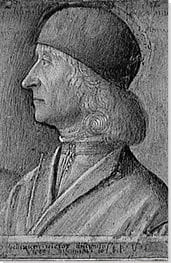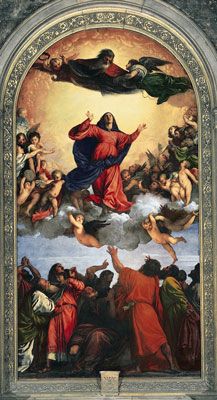Summary of Giovanni Bellini
Few artists in the history of painting can match the contribution of the Venetian, Giovanni Bellini. Bellini can be credited with bringing a humanistic quality to his religious and mythical scenes. He was also at the vanguard of developments in oil painting and, having dispensed of the egg and water tempera method, he used oil paints to evoke a heightened sense of scenic ambience. Whereas the painted landscape was generally viewed with a stuffy distain by the artistic elite, Bellini treated it with a respect and attention to detail that brought it, though much later, a new generic credibility. And, quite apart from his own magnificent contribution to the canon of the Renaissance, he tutored Titian who, remarkably, even surpassed his grand and graceful Venetian master.
Accomplishments
- Though a loyal son of Venice, Bellini was open to outside influences from within Italy and from Northern Europe. His work bears the influence of new ideas in anatomical perspective as well as a willingness to test the artistic possibilities for oil paint, newly exported into Italy through the port of Venice.
- For a man of such hardy Christian convictions, Bellini was resolved to using painting to convey the nuances of the human figure. His figures, both mortal and sacred, were painted thus with a lightness of touch that brought a new human tenderness to his religious and mythical parables.
- Bellini's experiments with oils only added to the general elegance of his work. He perfected through oils a technique that allowed for the most subtle gradations of color. His sophisticated paintings set the bar by which others would be judged.
- Unlike so many of his contemporaries, Bellini shows great respect for the natural landscape. The natural world was typically designed to add dramatic effect to the painted narrative, but there was a sparseness to Bellini's landscapes that were based on the open countryside in which he grew up.
- In addition to his subtle rendering of costume and skin pigmentation, Bellini was able to add to the meteorological ambience of his scenes through his great mastery of light and color.
The Life of Giovanni Bellini
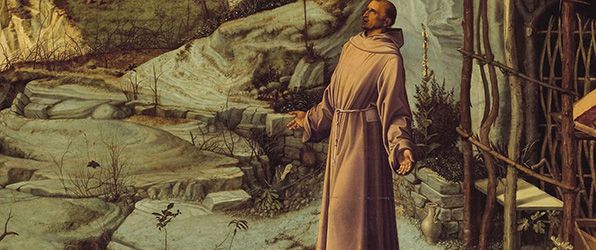
With his intense exploration of earthly space and natural light, Bellini’s work is masterful. Leading UK art critic Jonathan Jones has even described the Venetian master as a rival to Leonardo da Vinci himself.
Important Art by Giovanni Bellini
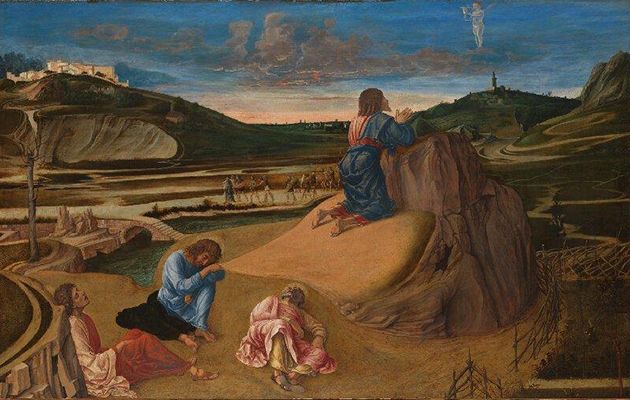
The Agony in the Garden
This painting depicts the common religious theme of Christ's time of prayer in the Garden of Gethsemane before being taken prisoner by the Roman soldiers as a result of Judas' betrayal. In this version Christ kneels at a rock mound in prayer, while the disciples, Peter, James and John, sleep on the ground behind him. Visible in the clouds above the kneeling Jesus is an angel, holding aloft a cup and paten as symbols of Christ's sacrifice to come. Beyond these foreground figures, in the distance, winding their way along the road, are the Roman soldiers with Judas in the lead. Bellini's fine religious parable acts also as an excellent example of his respect for the natural landscape.
The topography of this painting recalls the sparse open countryside of the Lombardi region. Bellini had grown up in natural surroundings like this and his love for nature married well with his fervent religious beliefs. Despite never travelling further than Mantua, he was however aware of the discoveries in perspective and drawing being made in Florence thanks to his father Jacopo's travels. This new learning inspired Bellini to render the natural world around him with a realism and religious devotion not seen before. Indeed, he chose to depict landscapes with which he was familiar rather than imagine elaborate and idealised scenes.
This painting is often compared to an earlier painting on the same subject by his brother in law, Mantegna, whose landscape is, by comparison, dramatic, somewhat cramped and heavily populated by angels and soldiers in close proximity. Bellini exchanges Mantegna's spires of Jerusalem for small hill top towns, much closer in reality to the settlements found in the countryside around Venice at the time. The sparseness of the countryside allows the procession of soldiers to be placed further back into the distance thereby generating a powerful sense of impending fate; the calm as the storm clouds gather in the distance.
Another remarkable aspect of this painting is Bellini's rendering of the tantalizing dawn light. The pink warmth of the rising sun is almost tangible as it catches the river and rocks and floods into the broad valley beyond the viewer. The light ripples over the back of Jesus's robes with an iridescence enhanced by the addition of gold to the blue. By continuing to harness light and color in this way, Bellini earned his reputation as the master at generating atmosphere.
Tempera on panel - The National Gallery, London
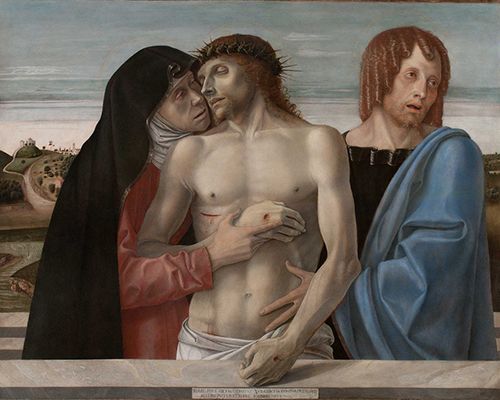
Pieta
Pieta depicts the dead body of Christ being held up by Mary and Joseph. His wounds from the sword and his crucifixion are still fresh. The three figures are positioned in the central foreground with an obscured (by the three figures) rural landscape unwinding behind them.
This painting is significant because it marks Bellini's move away from the stylistic practices of Mantegna and the Paduan school. It shows the artist exploring his own, more serene and intimate style; a style that was softer than that seen in his previous paintings. His open low-lying landscape is suffused with natural light and opened up yet further by the horizontal fleeting clouds and sky. The stiffly-wrapped drapery of his costumes is replaced by far softer, more sweeping, folds. The grace these peripheral changes add to the image support an intimacy of feeling between the mother and her dead son (for there can be no higher love than that between mother and only son) which is immensely powerful in its tenderness. This was an aspect of Bellini's work that becomes a recognizable feature in his paintings to come. Also noticeable here are the beginnings of his ability to infuse classical themes and compositions with personal interpretation. Though he has a vital compositional function as a third party in the triptych, the somewhat stilted figure of Joseph (when compared to Mary) is still clearly absorbed in personal grief.
The fervour of religiosity so keenly depicted in Bellini's earlier work has dissipated and become something more refined and humanistic. As the art historian Roger Fry put it, "The sorrow which Bellini has here conceived is divine only in its excess of humanity." It is the simple, universal and agonising loss of a mother the viewer feels here over the loss of an ardent disciple. This is, in part, thanks to the development of the artist's rendering of the human figure. The move away from an emphasis on line and contour, towards more modelled planes and shading gives dead weight to Christ's arms and softness to his skin, he is almost ready to slump out of the image.
Tempera on Panel - Pinacoteca Brera, Milan, Italy
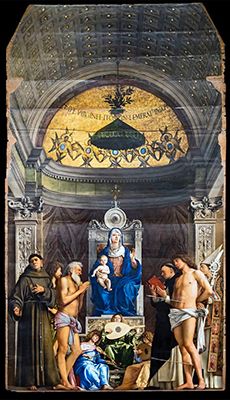
The Sacred Conversation
This altarpiece was originally painted for the church of St Giobbe in Venice. It depicts the common religious theme of The Virgin Mary in consultation with a group of saints and a heavenly gathering. In this particular painting the saints depicted are, from left to right, St Francis, St John, St Job, St Dominic, St Sebastian and St Louis. At the base of The Virgin's throne sit three angels with musical instruments.
This painting was the first example of The Sacred Conversation set within the architecture of a Venetian church. Previously, the divine group were set within a heavenly setting, whereas here Bellini brings them right down to earth. In its original place within the church of St Giobbe, the painting would have been surrounded by pillars similar to those within the space of the painting creating the illusion that The Virgin, Christ and all the saints were within reach of the worshipper. This effect would have been intensified by the familiar architecture of the painting, which is so reminiscent of the interior of St Mark's Basilica, the greatest church in Venice. The gold of the cupola and the marble that lines the walls behind the Madonna are both very recognisable features of The Basilica and, having been looted from Constantinople in the 13th century, were also symbolic of Venetian international power. This use of an architectural setting for biblical scenes went on to influence many future religious painters, notably Fra Bartolomeo in his Mystic Marriage of St Catherine in 1512, now held in the Accademia in Florence.
The warmth of the golden light within this picture may well have been inspired by the sacred and mysterious light of the Basilica generated by the vast quantities of gold on its walls. The atmosphere is certainly one of the reasons this picture is worth noting. By this point Bellini is painting more and more in oil and in this example he uses oil to layer thin layer upon thin layer, giving richness and depth to the light suffusing the scene.
Despite the inviting gesture of St Francis and the delicate rendering of the largely naked figures of St Job and St Sebastian, there is still a removed and slightly distant nature to Bellini's figures here. He is still conforming to the idea of representing a type with the saints, rather than a personality, though this was to change dramatically later on in his career. Here though there is a feeling that he is still displaying his mastery of the skills of lifelike representation and that something of the raw emotion of his earlier Pieta has been sacrificed in the study of St Sebastian's technical positioning and the Madonna's austere expression.
Oil on Panel - Galleria dell' Accademia, Venice
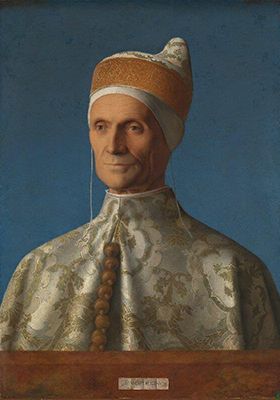
Doge Leonardo Lorodan
Bellini's portrait was most probably completed in the first year of Doge Leonardo Lorondan's rule. It shows the bust of the Doge in full ceremonial dress, in three quarter view, sitting behind a pedestal before an open blue background. The painting is most significant because of its importance to Venetian portraiture and Italian Renaissance art as a whole.
The fifteenth century was witness to big changes in formal approaches to art. The increasing ability of artists to render truly lifelike portraits meant demand soared during the first half of the sixteenth century too. Vasari (writing in 1550) stated that Bellini "introduced into Venice the fashion that everyone of a certain rank should have his portrait painted either by him or by some other master." Though Florence is often considered the forerunner of the Renaissance, Venice's trade links meant the great artists' studios, like Bellini's, were open to advances in other countries, most notably the Netherlands, but also through Sicily, another vibrant trading port.
This portrait shows evidence of a Dutch influence. Firstly, and most notably, the sitter is depicted in three quarter view as opposed to the more usual Italian profile of the time. Though this is not the first use of this technique in Italy it is a prime example of how much more intimate and powerful the viewers' connection to the sitter becomes in this format. Secondly the sitter is positioned behind a pedestal, placing him in space, with the illusion that he is just there on the other side of an opening to the viewer. And lastly, it is painted in oil rather than tempera. Bellini's mastery of this medium, new to Venice and Italy at the turn of the century, enabled him to paint with the subtlety that here renders the Doges' skin so soft and realistic.
The picture also displays the sparseness and the sense of light more closely associated with the Dutch masters. But here Bellini is adapting it for specific reasons. Fiercely and proudly republic, Venice was aware of the dangers of celebrating the power of a single elected individual and the doge was constantly held accountable by his peers. Doge Lorodan campaigned (and won his election) on the strength of these democratic ideals, effectively presenting Bellini with the task of portraying the ruler of Venice without elevating him personally. Subsequently this portrait is possessed with the diffused blue sky light of Venice. The serenity and averted focus of the Doge's eyes perfectly personifies "The Most Serene Republic of Venice" (as it was often called) while the ceremonial robes describe the state's love of pageantry and tie the sitter firmly to his office. This is a picture of the ruling doge as the personification of his proud city.
Oil on poplar board - The National Gallery, London
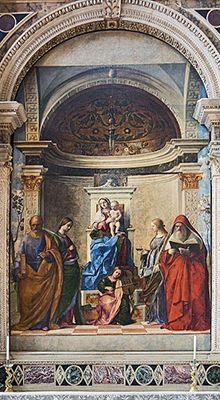
The Sacred Conversation
This painting, once more an example of oil on board, is widely considered Bellini's finest work. The art critic, John Ruskin, went so far as to describe it as the best painting in the world. It too depicts the common religious theme, the Sacred Conversation. As with many other examples, it shows the Madonna and Child at the centre of the painting, flanked on both sides by the figures of saints, arranged in a traditional pyramidal structure. In this case the saints are, from left to right, St Peter, St Catherine, St Lucy and St Jerome. The group are positioned within sacred architecture, The Madonna and Child enthroned beneath a half cupola.
Made very late on in his career, this painting shows the entirety of Bellini's mastery in rendering the human figure and perspective. It is also an example of how he used color to knit together the composition. The contrasting and complementary arrangements of the robes of the saints generate a harmony between them that is deeper than the simply structural. The poise and serenity of the faces of the saints, St Catherine's far away smile and St Jerome's absorption in his book, give the saints a life of their own with which they are very rarely seen, and which is not present in the earlier St Giobbe altarpiece. Ernst Gombrich describes the significance of this in the popular art history tome "The Story of Art" when he says, "In the earlier days, the picture of the Virgin used to be rigidly flanked by the traditional images of the saints. Bellini knew how to bring life into simple symmetrical arrangement without upsetting its order." Set above a side alter in The San Zaccaria Church in Venice, the painting and its perspectival architecture give, as with the St Giobbe example, the illusion of being simply an extension of the inner space of the church. Thanks to the peripheral views of the open landscape, however, this example gives a greater sense of light and space than its illustrious predecessor.
Oil on board - San Zaccaria Church, Venice
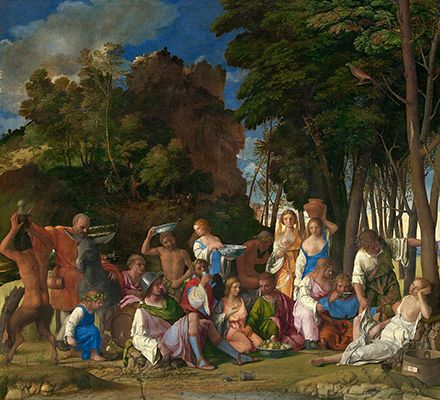
The Feast of the Gods
This is the greatest example of the small number of secular pictures that Bellini made toward the end of his life. The painting is a complicated composition reminiscent of a roman frieze in its horizontal layout. It depicts a scene from Ovid in which some seventeen figures including Bacchus, Hermes, Jupiter, Pan, Neptune and Apollo, feast in the forest. It was commissioned by the duke of Ferrara for his study and thus the subject matter was allowed to be of a more private nature. Many of the goddesses and nymphs have their breasts exposed and Priapus, the man in green to the right-hand side of the painting is attempting to lift the skirt of the sleeping Lotis. There are many symbols of sexuality running through the painting and it is thought the couple in the centre, the lady in peach and the man next to her with his hand between her thighs were portraits of the Duke and his wife.
Though Dosso Dossi made alterations to the painting after Bellini's death (at the behest of the Duke) the main alteration was by Titian who reworked the landscape, while leaving the original Bellini figures intact. The painting is filled with the vibrant colors Bellini was famous for, most notably the blue robe of the young Bacchus on the left. Though these figures are gods there is really very little to delineate them as such. To all intents and purposes this is a naturalistic scene of people enjoying life in the landscape. This interpretation may be due to Bellini's inexperience at this type of painting, but it may also come down to his humanization of mythical characters normally considered beyond the reach of mortality.
Oil on Canvas - The National Gallery of Art, Washington DC
Biography of Giovanni Bellini
Childhood
Scant written evidence exists as to the specifics of Giovanni Bellini's childhood. The sixteenth-century artist and biographer Giorgio Vasari recorded in his book Lives of the Most Excellent Painters, Sculptors and Architects that Bellini was 90 when he died, making 1426 his year of birth. But contemporary art historians believe that it is more likely that he was born a little later, sometime between 1430 and 1432. His parenthood has also been disputed with recent claims being made by art historian Daniel Maze that Jacopo Bellini, long considered his father, was in fact his elder brother. There is no dispute however over the fact that the artist was born in Venice. Jacopo was himself an artist, though now better known thanks to the enduring celebrity of his more famous sons who were much admired in Venice and indeed allover northern Italy. As their numerous correspondences attest, Giovanni was close to his brother Gentile, and the two learnt the skills of drawing and painting together under the tutelage of their father.
The Bellini brothers benefitted early on from their father's extensive travels throughout Italy, especially Florence and other Tuscan towns which were seeing advances in anatomical studies and perspective. Though Venice was not a seat of learning, the city still gave the young brothers the best of starts as artists. It was after all one of the richest and best governed capitals in the world with a seemingly veracious appetite for beautiful and extravagant art.
In 1443 Bellini accompanied his father on a working trip to Padua. Whilst there it is likely the impressionable teen-aged boy witnessed the preaching of Saint Bernardino. In the more southern reaches of modern-day Italy there had been a blossoming of Renaissance Humanism and a move away from Christianity, a school of thought to which Jacopo himself had ascribed. Saint Bernardino led a powerful resurgence of religious fervour in the country during the middle of the fifteenth century, often preaching for hours in the open air with eloquence and passion on the virtues of the Christian faith. It is very likely that this was the event that began, what was to be for Giovanni, a lifelong and deep devotion to the Christianity.
Education
Despite having two such promising protégés as sons, Jacopo was keen to expand "his School" and having noticed the precocious talent of the young artist Andrea Mantegna on a visit to Padua in the early 1450s, he promptly arranged the marriage of Mantegna to his daughter Nicolosa. Bellini found himself with a new brother in law and Mantegna was to exert a profound effect on Giovanni's practice. It would seem that the relations between the two were exceedingly amicable, and although Mantegna moved to Mantua in 1460, they continued a productive relationship for the rest of Mantegna's lifetime.
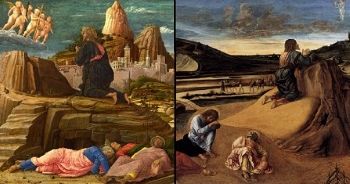
In the years before 1460 Bellini's work shows an intensity in religious feeling that seems to be entirely his own. Art historian Roger Fry writing in 1899 describes how Jacopo's religious sketches "treated religious subjects with surprising levity" whereas in the work of his son "the feelings of pity and love are expressed with such frequency and with such intimate intensity" as to make his devotion palpable. It was with the same devotion that he committed himself to mastering the developments in rendering the human figure. Perhaps because of his early life in the university town of Padua, or perhaps because of his more extrovert nature, it makes sense that Mantegna was the one to lead the way for Bellini in this Paduan School of painting. His influence on his brother-in-law is clear when comparing the two men's work before 1460.
In addition to his brother-in-law, one sees clear links to the work of the Florentine sculptor and painter Donatello who had spent time in Padua between 1440 and 1450. The influence of the painter Carlo Crivello is also evident in his early work. Crivello was in fact a student of the only alternative school of painting to the Bellini's in Venice, The Vivarinis. A rivalry grew up between the two schools and this competitiveness acted as a spur for Bellini who took it upon himself to stay abreast of artistic developments beyond Venice. Yet despite this local rivalry, Bellini is also credited with an openness and generosity with other artists.
Early Career
In 1459, Bellini married Ginevra Bocheta. The pair had at least one son, whom they named Alvise. Family life did not seem to dull his desire to excel at his art, however. His growing confidence at this time is clear as he threw off the occasionally austere and self-conscious linear nature of the Paduan School. He still seemed to be drawing inspiration from Mantegna, despite his friend's move to Mantua. But his work from 1460 onward shows definite indications of the grace and elegance unique to his later works. His brother Gentile was considered the greater of the two brothers at this point, but this did not seem to have created enmity between them. In 1470 the brothers, with several other artists, were commissioned to paint works of the Old Testament in the Scuola di San Marco. Bellini produced a painting of The Deluge with Noah's Ark, which was much acclaimed at the time but sadly has not survived to the present day.
Mature Career
In 1473 a painter by the name of Antonello di Messina arrived in Venice. The exact reach of the man's travels is unknown, but it is certain he had travelled to Northern Europe, most notably the Netherlands, and that this had had a huge influence on Bellini's work. Significantly di Messina had adopted the Northern European practice of painting in oils and it is widely thought (though sometimes contested) that he was responsible for their arrival in Venice, and throughout Italy subsequently. Bellini begins to paint in oils and the new medium seems to have agreed with his developing elegance and allowed him a subtlety in graduating color and atmosphere that were previously impossible to achieve with tempera. It could be argued that this technical advancement marked the beginning of when Bellini really began to settle into his professional stride.
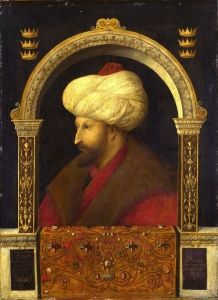
In 1479, Bellini's brother Gentile traveled to Constantinople leaving his post as conservator to the halls of the Doge. Giovanni and Vivarini were jointly appointed to continue the work. During the course of their tenure Vivarini died, however, leaving Giovanni in sole possession of the significant role. Sadly, the substantial amount of work Bellini completed in these halls was lost entirely to fire in 1577. The appointment cemented him as the greatest painter in the city at the time and in 1483 he was appointed official painter of Venice. It is during the 1490s and in the first few years of the 1500s that he took on, first Giorgione, and later Titian, as pupils. Both men would go on to make a significant impact on the Venetian Renaissance, and in the process they helped to further secure Bellini's legacy.
Late Period
From 1500 onward, Bellini was overwhelmed with commissions. He was however financially secure and even began to turn away potential patrons. Isabella Gonzaga of Mantua requested a secular scene of ancient Greek myth, a genre of painting also called all 'Antica. This was the second picture she would have received from Bellini, but he declined. It is often argued that this was because 'Antica pictures Bellini was technically incapable of producing, or that he declined for religious reasons. It is far more likely, however, and fits much better with what is surmised of Bellini's character, that he declined out of respect to his brother in law Mantegna. Mantegna was still court painter to the Gonzagas and specialized in this type of painting and it is highly possible that Bellini simply did not want to encroach on his territory. This interpretation is supported but the fact that in 1514, after Mantegna's death, Bellini produced The Feast of The Gods for the Duke of Ferrara, thus proving his technical ability and refuting all alleged religious qualms.
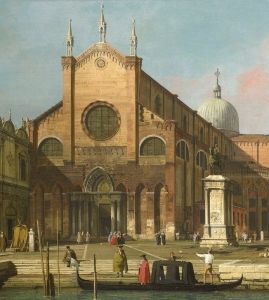
His work during the last 16 years of his life bares such refined elegance it is hard to resist the inference that he was a content and accomplished master in his old age. When Albrecht Dürer visited Venice for the second time in 1505, he was scathing about the welcome he received from every artist but Bellini of whom he said, "He is very old but still the greatest artist of them all" (an endorsement that may have had something to do with the fact that Bellini bought one of Dürer's paintings on this visit). In 1507 Gentile died ending one of the closest relationships of Bellini's life. Gentile left his brother their father's sketchbook and in return Giovanni completed Gentile's unfinished The Preaching of St Mark. Following his own death in 1516 Giovanni Bellini was honorably buried with his brother in the church of San Giovanni e Paolo, the resting place of the Doges.
The Legacy of Giovanni Bellini
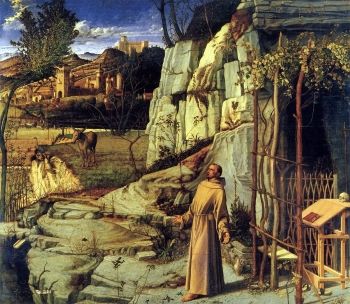
Giovanni Bellini left two major legacies to the art world. First was his skill in bringing a tangible sense of ambience to his painting, and second, the new possibilities he opened up when he imbued religious deities with corporeal qualities. His own achievements were however surpassed by his pupil Titian who became the great colossus of 16th century Venetian art and, towards the end of his career, a forerunner for the more expressive Mannerist style which duly took over from the more naturalistic High Renaissance. Titian took from Bellini his subtle and serene blending of color and light while bringing to it a fresh drama and dynamism. Similarly, as Bellini had learnt much from the Dutch masters, Albrecht Dürer came back from his visits to Venice to infuse his later portraits with a Belliniesque, Venetian hue.
And though it was not acknowledged in his own lifetime, Bellini has left his indelible mark on landscape painting which was derided by serious artists of his own time. It was only many centuries after his death that the significance and attention he paid to the details of the natural world received its just recognition. Indeed, a convincing argument can be made for Bellini as the father of landscape painting and it is certain that later painters, such as Albrecht Dürer, were heavily influenced by him in their naturalistic pursuits.
Influences and Connections

-
![Donatello]() Donatello
Donatello -
![Albrecht Dürer]() Albrecht Dürer
Albrecht Dürer -
![Giorgione]() Giorgione
Giorgione -
![Titian]() Titian
Titian - Antonello di Messina
-
![Andrea Mantegna]() Andrea Mantegna
Andrea Mantegna - Jacopo Bellini
- Gentile Bellini
- Saint Bernadino
-
![Titian]() Titian
Titian -
![Albrecht Dürer]() Albrecht Dürer
Albrecht Dürer - Fra Bartolomeo
-
![Andrea Mantegna]() Andrea Mantegna
Andrea Mantegna - Gentile Bellini
-
![High Renaissance]() High Renaissance
High Renaissance -
![Mannerism]() Mannerism
Mannerism - Landscape Painting
Useful Resources on Giovanni Bellini
- Giovanni BelliniOur PickBy Roger Fry
- Lives of the Most Eminent Painters, Sculptors and ArchitectsBy Giorgio Vasari
- Lives of Giovanni BelliniBy Giorgio Vasari, Carlo Ridolfi, Marco Boschini, Isabella d'Este, Davide Gasparotto
- Mantegna and Bellini: A Renaissance FamilyBy Caroline Campbell, Dagmar Korbacher, Neville Rowley, Sarah Vowles, Andrea De Marchi
 Ask The Art Story AI
Ask The Art Story AI